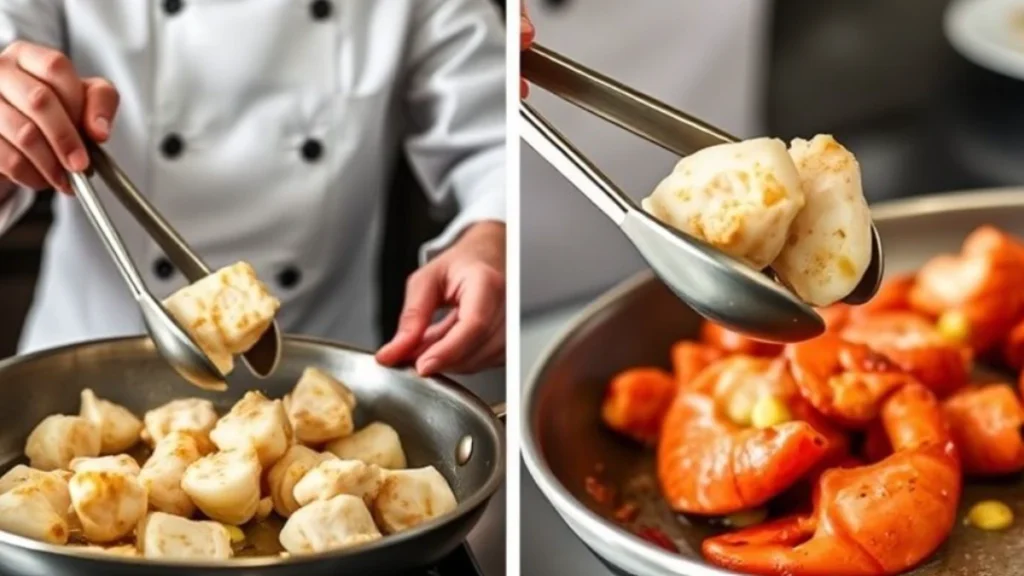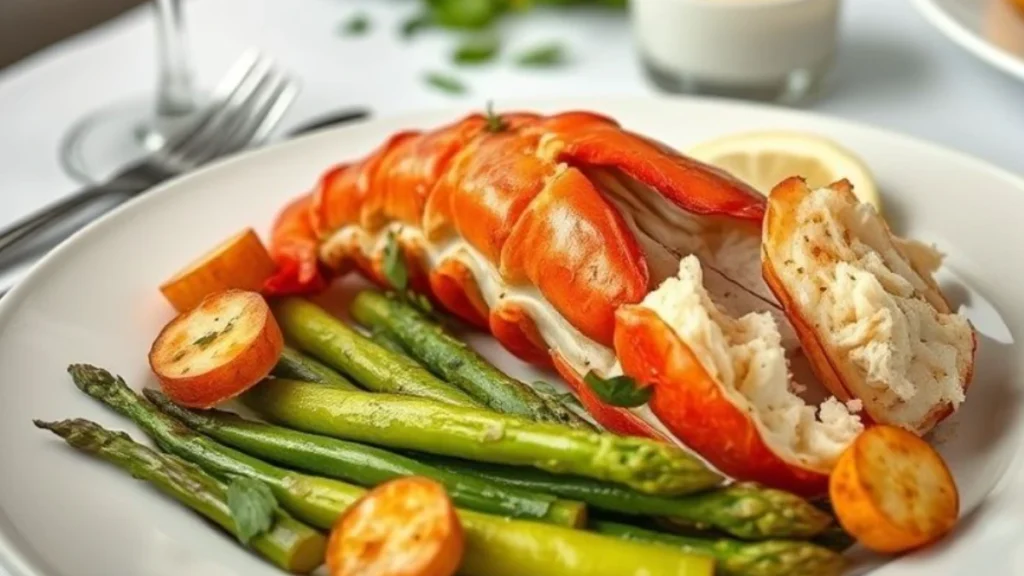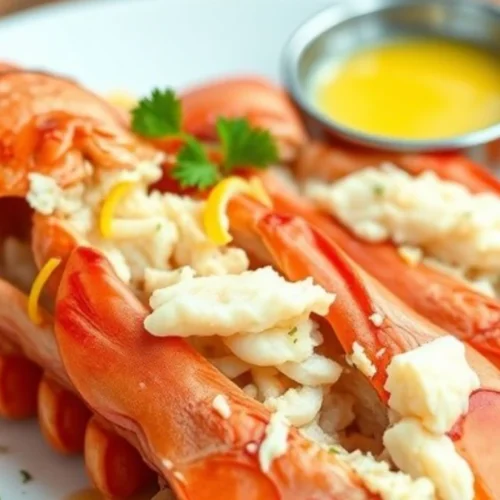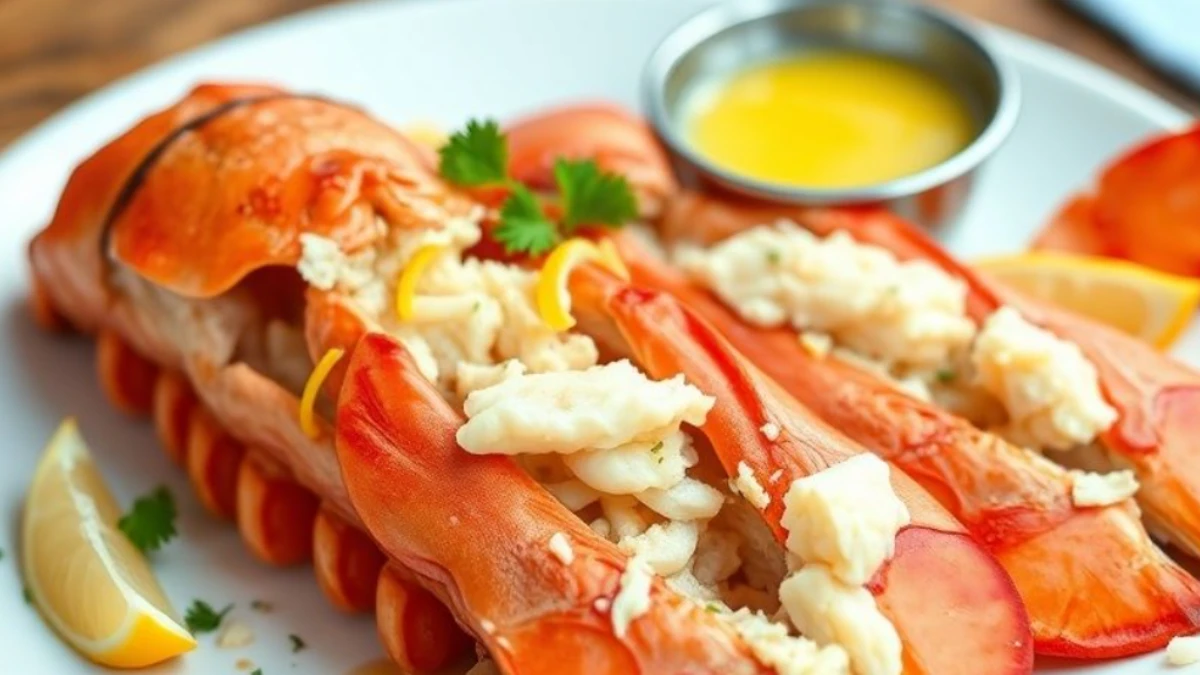Have you ever wondered how to achieve tender, restaurant-quality lobster meat right in your own kitchen? Whether you’re craving butter-poached lobster for a gourmet dinner or the perfect filling for a classic lobster roll, mastering the art of cooking lobster meat is easier than you think.
With just a few simple techniques, you can unlock the rich, delicate flavors of fresh lobster meat while keeping its texture perfectly tender. This guide will walk you through quick and foolproof methods, pro tips, and creative variations to elevate your seafood game. Ready to dive in? Let’s get started!
Table of Contents
Key Benefits of Cooking Lobster Meat the Right Way
Cooking lobster meat at home might seem intimidating, but once you know the secrets, it’s surprisingly simple! Whether you’re making butter-poached lobster for an elegant meal or adding tender chunks to a seafood pasta, properly cooked lobster enhances both flavor and texture. Here’s why learning these quick techniques will transform your home cooking:
Unmatched Freshness & Flavor – Cooking fresh lobster meat yourself ensures rich, buttery sweetness that pre-cooked versions often lack.
Perfectly Tender Texture – Avoid rubbery or overcooked lobster by using gentle cooking methods like steaming, poaching, or sautéing.
Versatile for Any Dish – From lobster rolls to creamy bisques, knowing how to prepare lobster meat gives you endless meal possibilities.
Cost-Effective Gourmet Experience – Preparing lobster at home lets you enjoy a luxury seafood dish at a fraction of restaurant prices.
Quick & Simple Preparation – With the right tips, you can have succulent lobster meat ready in under 10 minutes!
By understanding these key benefits, you’ll feel more confident handling lobster in your kitchen. Now, let’s gather the ingredients and start cooking!
Ingredients You’ll Need
Before we start cooking, let’s make sure you have all the essentials. Choosing high-quality ingredients is key to getting that tender, flavorful lobster meat every time.

Essential Ingredients:
- 1 pound fresh lobster meat (claw, knuckle, or tail) – for the best texture and flavor
- 4 tablespoons unsalted butter – essential for a rich, buttery finish
- 2 cloves garlic, minced – adds depth and aroma
- 1 teaspoon lemon zest – brightens and enhances the natural sweetness
- ½ teaspoon seafood seasoning – perfectly complements the lobster’s delicate taste
- ¼ teaspoon salt – enhances flavor without overpowering
- ¼ teaspoon black pepper – adds a gentle warmth
Optional Additions for Extra Flavor:
- ½ cup white wine – creates a light, aromatic poaching liquid
- 1 tablespoon fresh parsley, chopped – brings a pop of color and freshness
- Pinch of red pepper flakes – for a subtle kick of heat
- 1 teaspoon Dijon mustard – adds a tangy depth to butter-based sauces
Having everything prepped and measured makes cooking a breeze. Now, let’s move on to the best method for cooking your lobster meat to perfection!
Method for Cooking Lobster Meat to Perfection
Now let’s dive into the fun part—cooking your lobster meat! Whether you’re looking for a rich, buttery finish or a quick sauté for crispy edges, these methods will ensure you enjoy perfectly tender lobster every time.

Step 1: Prepare the Lobster Meat
If you’re working with frozen lobster meat, make sure to fully thaw it before cooking. If it’s fresh, rinse it gently under cold water and pat it dry with a paper towel. Dry lobster meat will sear better if you’re sautéing, and it helps to prevent excess water when poaching.
Step 2: Choose Your Cooking Method
There are a couple of simple and effective methods for cooking lobster meat at home. Let’s take a look at each one:
Butter Poaching (for a rich, delicate flavor):
- Melt 4 tablespoons of unsalted butter in a medium saucepan over low heat.
- Add 2 minced garlic cloves and let them cook for about 1 minute until fragrant—don’t let them brown!
- Add the lobster meat, ensuring it’s coated in the butter. Let it simmer gently for about 3-4 minutes, until the lobster turns opaque and tender.
- Season with 1 teaspoon of lemon zest, ½ teaspoon seafood seasoning, and a pinch of salt and pepper. Stir to combine, and remove from heat once done.
Sautéing (for a quick, crispy edge):
- Heat 1 tablespoon of butter or olive oil in a large skillet over medium-high heat.
- Add the lobster meat and sauté for 2-3 minutes, stirring occasionally to ensure even cooking.
- Season with garlic, lemon zest, salt, and pepper for that extra burst of flavor.
- Once the lobster meat is opaque and tender, remove from heat. You’re ready to serve!
Step 3: Check for Doneness
Lobster meat cooks quickly, so keep a close eye on it. It should be firm yet tender when touched. The color should change from translucent to opaque, and it should be moist but not watery. Overcooking lobster can make it tough, so be mindful of the cooking time.
Pro Tips for Perfect Lobster Meat:
- Low and slow works best! If you’re poaching, keep the heat low to ensure the lobster doesn’t become rubbery.
- Don’t overcrowd your pan when sautéing. If you have a lot of lobster, cook it in batches to avoid steaming the meat.
- For an extra indulgent touch, drizzle some clarified butter on top once the lobster is done. It adds richness and helps to bring out those oceanic flavors.
Now that you’ve perfected the cooking method, let’s move on to the best ways to serve your lobster meat!
Pro Tips and Variations for Cooking Lobster Meat
Ready to take your lobster cooking skills to the next level? Here are some expert tips and fun variations to help you experiment with flavor and texture. Whether you’re a seasoned pro or new to lobster meat, these ideas will add versatility and creativity to your dishes.
Pro Tips for Cooking Lobster Meat
- Don’t Overcook It! – Lobster cooks quickly, and overcooking can lead to tough, rubbery meat. Whether you’re poaching or sautéing, aim for lobster meat that’s just opaque, with a tender bite.
- Butter Is Your Friend – Butter enhances the sweetness of lobster meat, adding richness and depth. Try clarified butter for an even more luxurious touch.
- Infuse Flavor with Aromatics – Fresh herbs, like thyme or rosemary, can be added to the butter or poaching liquid to impart even more flavor to your lobster meat. Don’t forget about garlic and lemon zest—they’re simple but powerful additions.
- Seasoning Matters – While lobster has a delicate flavor, adding seafood seasoning or a sprinkle of smoked paprika can elevate the taste and provide balance. Just be mindful not to overpower the lobster’s natural sweetness.
Delicious Variations to Try
- Lobster in Garlic Butter Sauce – Combine melted butter, garlic, lemon juice, and a pinch of chili flakes for a tangy, flavorful sauce to coat your lobster. This is a great option for serving as an appetizer or on top of pasta.
- Lobster and Herb Risotto – Add sautéed lobster meat to a creamy risotto for a rich and luxurious dish. The lobster will absorb the subtle flavors of the creamy rice and herbs.
- Lobster Roll – For a quick and crowd-pleasing variation, serve your cooked lobster meat in a buttered and toasted brioche bun with a touch of mayo and lemon. The perfect summer dish!
- Lobster Bisque – Turn your lobster meat into a creamy bisque for a warm and comforting meal. This variation calls for simmering lobster shells to create a rich stock, then blending with the lobster meat for a silky-smooth soup.
For a More Elevated Experience
- Pair with White Wine – Lobster and white wine are a match made in heaven. Choose a dry white wine, like Chardonnay or Sauvignon Blanc, to complement the buttery richness of the lobster.
- Garnish with Fresh Herbs – Sprinkle chopped fresh parsley or tarragon on your finished lobster dish for a burst of freshness and a pop of color.
With these pro tips and delicious variations, you’re ready to explore all the ways you can enjoy lobster meat. Whether you’re preparing a simple dinner or something special for guests, these ideas will elevate your seafood game
Serving Suggestions for Your Lobster Meat
Now that your lobster meat is perfectly cooked, it’s time to think about how to serve it! Whether you’re preparing a casual weeknight dinner or an elegant special occasion meal, these serving ideas will highlight the delicious flavors of your lobster meat and impress your guests.

1. Lobster Rolls
A classic choice that never goes out of style! To create the perfect lobster roll:
- Use a buttery, toasted brioche bun to cradle your lobster meat.
- Mix the lobster with a bit of mayo, a squeeze of fresh lemon juice, and a sprinkle of fresh herbs like dill or tarragon.
- Add a dash of seafood seasoning for an extra burst of flavor.
Serve your lobster roll with crispy fries and a side of coleslaw for a complete meal.
2. Lobster with Garlic Butter and Roasted Vegetables
For a more elegant option, serve your lobster meat alongside roasted vegetables such as asparagus, baby potatoes, or carrots. The sweet, tender lobster pairs perfectly with the earthy flavors of roasted veggies.
- Drizzle the lobster with homemade garlic butter for added richness.
- For a fresh finish, garnish with chopped parsley or a squeeze of lemon juice.
3. Lobster Pasta
Lobster meat adds a luxurious touch to any pasta dish. To make a quick lobster pasta:
- Toss the cooked lobster meat with linguine or fettuccine, then coat with a light lemon and white wine sauce.
- Add fresh herbs like basil or parsley for a burst of flavor.
- For extra richness, finish with a sprinkle of Parmesan cheese.
4. Lobster Bisque
Transform your lobster meat into a creamy, indulgent bisque. This dish is perfect for colder months and will surely wow your guests.
- Use lobster shells to make a rich, flavorful broth, then add the lobster meat to finish.
- Serve with a side of crusty bread for dipping.
5. Lobster Salad
For a lighter option, toss your lobster meat with fresh greens for a simple lobster salad.
- Combine lobster with mixed greens, avocado, and a citrus dressing.
- Add a few slices of cucumber or cherry tomatoes for extra crunch and flavor.
6. Lobster Tacos
For a fun and unexpected twist, serve lobster meat in soft corn or flour tortillas.
- Top with a tangy slaw made from shredded cabbage, lime, and a bit of chili powder.
- Garnish with fresh cilantro and a drizzle of creamy avocado sauce.
Pairing Suggestions:
- Wine: Lobster meat pairs beautifully with a crisp white wine like Chardonnay, Sauvignon Blanc, or even a light sparkling wine.
- Side Dishes: Complement your lobster with light side dishes like garlic butter potatoes, sautéed spinach, or a fresh tomato salad.
With these serving suggestions, you can enjoy lobster meat in a variety of ways that suit any occasion. Whether you’re serving a casual lobster roll or an elegant lobster bisque, your meal will be memorable and delicious
Conclusion: The Joy of Cooking Lobster Meat
Congratulations! You’ve mastered the art of cooking lobster meat to perfection. Whether you chose to sauté, poach, or explore one of the many delicious variations, you now have a versatile, flavorful ingredient that can shine in a variety of dishes.
Cooking lobster doesn’t have to be intimidating. With the right techniques and a bit of practice, you can enjoy restaurant-quality lobster at home, whenever you want. From lobster rolls to lobster bisque, there are endless ways to bring out the natural sweetness and tender texture of this beautiful seafood.
Why Lobster Meat Is Worth It
Lobster meat is not only a delicacy, but it’s also incredibly versatile. It can elevate simple dishes like pasta or sandwiches, while also serving as the star of the show in more elaborate meals. Plus, it’s packed with protein and healthy fats, making it a great option for those looking for a flavorful yet nutritious meal.
Remember, the key to great lobster is in the preparation. Whether you’re following the classic butter-poaching method or opting for a quick sauté, the result will be worth it.
Make It Your Own
Don’t be afraid to get creative with your lobster dishes! Try out different seasonings, sauces, or side dishes to customize the meal to your liking. Lobster is a canvas for endless culinary possibilities.
With these tips, serving suggestions, and step-by-step guidance, you now have everything you need to make lobster meat a regular part of your cooking repertoire. Happy cooking!

Lobster Meat
Ingredients
Ingredients You’ll Need
- Before we start cooking let’s make sure you have all the essentials. Choosing high-quality ingredients is key to getting that tender, flavorful lobster meat every time.
Essential Ingredients:
- 1 pound fresh lobster meat claw, knuckle, or tail – for the best texture and flavor
- 4 tablespoons unsalted butter – essential for a rich buttery finish
- 2 cloves garlic minced – adds depth and aroma
- 1 teaspoon lemon zest – brightens and enhances the natural sweetness
- ½ teaspoon seafood seasoning – perfectly complements the lobster’s delicate taste
- ¼ teaspoon salt – enhances flavor without overpowering
- ¼ teaspoon black pepper – adds a gentle warmth
Optional Additions for Extra Flavor:
- ½ cup white wine – creates a light aromatic poaching liquid
- 1 tablespoon fresh parsley chopped – brings a pop of color and freshness
- Pinch of red pepper flakes – for a subtle kick of heat
- 1 teaspoon Dijon mustard – adds a tangy depth to butter-based sauces
Instructions
Method for Cooking Lobster Meat to Perfection
- Now let’s dive into the fun part—cooking your lobster meat! Whether you’re looking for a rich, buttery finish or a quick sauté for crispy edges, these methods will ensure you enjoy perfectly tender lobster every time.
Step 1: Prepare the Lobster Meat
- If you’re working with frozen lobster meat, make sure to fully thaw it before cooking. If it’s fresh, rinse it gently under cold water and pat it dry with a paper towel. Dry lobster meat will sear better if you’re sautéing, and it helps to prevent excess water when poaching.
Step 2: Choose Your Cooking Method
- There are a couple of simple and effective methods for cooking lobster meat at home. Let’s take a look at each one:
- Butter Poaching (for a rich, delicate flavor):
- Melt 4 tablespoons of unsalted butter in a medium saucepan over low heat.
- Add 2 minced garlic cloves and let them cook for about 1 minute until fragrant—don’t let them brown!
- Add the lobster meat, ensuring it’s coated in the butter. Let it simmer gently for about 3-4 minutes, until the lobster turns opaque and tender.
- Season with 1 teaspoon of lemon zest, ½ teaspoon seafood seasoning, and a pinch of salt and pepper. Stir to combine, and remove from heat once done.
- Sautéing (for a quick, crispy edge):
- Heat 1 tablespoon of butter or olive oil in a large skillet over medium-high heat.
- Add the lobster meat and sauté for 2-3 minutes, stirring occasionally to ensure even cooking.
- Season with garlic, lemon zest, salt, and pepper for that extra burst of flavor.
- Once the lobster meat is opaque and tender, remove from heat. You’re ready to serve!
Step 3: Check for Doneness
- Lobster meat cooks quickly, so keep a close eye on it. It should be firm yet tender when touched. The color should change from translucent to opaque, and it should be moist but not watery. Overcooking lobster can make it tough, so be mindful of the cooking time.
Notes
- Calories: 230
- Fat: 15g
- Saturated Fat: 7g
- Cholesterol: 70mg
- Sodium: 450mg
- Carbohydrates: 3g
- Fiber: 1g
- Sugar: 1g
- Protein: 20g
FAQs About Cooking Lobster Meat
It’s normal to have a few questions when it comes to cooking lobster meat. Below are some of the most frequently asked questions, along with answers to help guide you on your lobster cooking journey.
1. How do I know when lobster meat is fully cooked?
Lobster meat is done when it turns opaque and is firm to the touch. Whether you’re poaching, sautéing, or steaming, make sure the lobster reaches a temperature of around 140°F (60°C). Overcooking can lead to rubbery texture, so keep an eye on it!
2. Can I cook frozen lobster meat?
Yes, you can cook frozen lobster meat! If you’re working with frozen lobster, it’s best to thaw it completely before cooking for the best texture. Simply place it in the fridge overnight or run cold water over the sealed packaging for a quicker thaw. Once thawed, follow the cooking instructions just as you would for fresh lobster.
3. What is the best way to store leftover lobster meat?
If you have leftover lobster meat, store it in an airtight container in the refrigerator for up to 2 days. For longer storage, freeze it by placing it in a freezer-safe bag or container, and it will last up to 3 months. When reheating, avoid overcooking the meat—gently warm it in a pan with a little butter to maintain its tenderness.
4. Can I use lobster meat in dishes other than seafood?
Absolutely! Lobster meat can be used in non-seafood dishes to add a luxurious touch. Try adding it to omelets, risottos, and even tacos for an indulgent twist. Its rich, slightly sweet flavor pairs well with many different cuisines!
5. Can I cook lobster meat in advance?
While lobster is best enjoyed fresh, you can cook the lobster meat in advance and store it in the refrigerator. Just make sure it’s fully cooled before refrigerating, and use it within 2 days. For even more convenience, you can freeze cooked lobster meat and reheat it gently when you’re ready to serve.
6. How do I remove lobster meat from the shell?
Removing lobster meat from the shell can be tricky, but with a little practice, it becomes easier. Start by cracking the lobster’s claws and removing the meat. Then, twist off the tail, and use a lobster fork or your fingers to pull out the meat. For a smoother process, use kitchen shears to cut along the underside of the tail and extract the meat in one piece.
Have you ever tried this recipe?
There are no reviews yet. Be the first one to write one.

